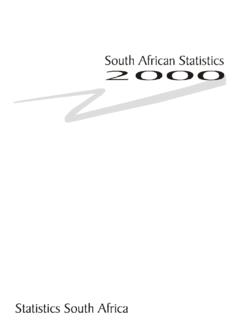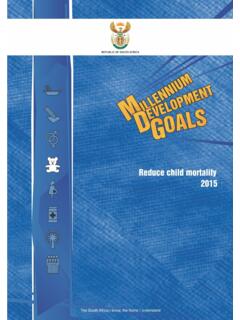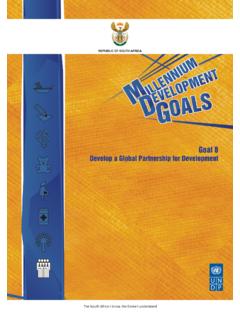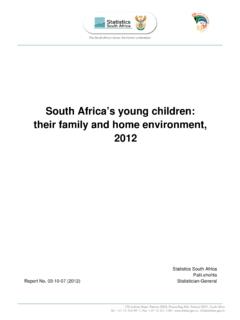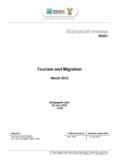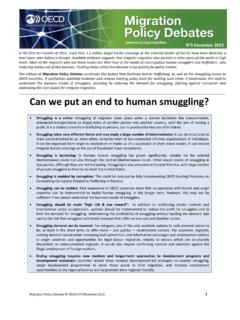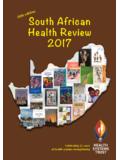Transcription of Mid-year population estimates - Statistics South Africa
1 Statistical release P0302 Mid-year population estimates2014 Embargoed until:31 July 2014 11:30 Enquiries: Forthcoming issue: Expected release date User Information Services Mid-year population estimates , 2015 July 2015 Tel: (012) 310 8600/4892/8390 Statistics South Africa P0302 Mid-year population estimates , 2014 1 Contents Summary .. 2 1. Introduction .. 4 2. Demographic and other assumptions.. 4 3. Indicators from Spectrum .. 5 4. National population estimates .. 7 5. Provincial population estimates .. 10 Demographic assumptions .. 10 Provincial distributions .. 12 migration patterns .. 12 Provincial estimates by age and sex .. 12 References .. 17 Tables Table 1: Mid-year population estimates for South Africa by population group and sex, 2014.
2 3 Table 2: Mid-year population estimates by province, 2014 .. 3 Table 3: Assumptions of expectation of life at birth without HIV and fertility .. 4 Table 4: migration assumptions for the period 1985-2015 .. 5 Table 5: Demographic indicators, 2002-2014 .. 6 Table 6: Births and deaths for the period 2002-2014 .. 6 Table 7: HIV prevalence estimates and the number of people living with HIV, 2002-2014 .. 7 Table 8: Mid-year estimates by population group and sex, 2014 .. 7 Table 9: estimates annual population growth rates, 2002-2014 .. 8 Table 10: Mid-year population estimates by population group, age and sex, 2014 .. 9 Table 11: Percentage distribution of the projected provincial share of the total population , 2002-2014 .. 12 Table 12: Estimated provincial migration streams, 2001-2006.
3 13 Table 13: Estimated provincial migration streams, 2006-2011 .. 13 Table 14: estimates provincial migration streams, 2011-2016 .. 14 Table 15: Provincial population estimates by age and sex, 2014 .. 15 Figures Figure 1: Provincial average total fertility rates for the periods 2001-2006, 2006-2011 and 2011-2016 .. 10 Figure 2: Provincial average life expectancy at birth, 2001-2006, 2006-2011 and 2011-2016 (males) .. 11 Figure 3: Provincial average life expectancy at birth, 2001-2006, 2006-2011 and 2011-2016 (females) .. 11 Statistics South Africa P0302 Mid-year population estimates , 2014 2 Summary This release uses the cohort-component methodology to estimate the 2014 Mid-year population of South Africa . The estimates cover all the residents of South Africa at the 2014 Mid-year , and are based on the latest available information.
4 estimates may change as new data become available. For 2014, Statistics South Africa (Stats SA) estimates the Mid-year population as 54 million. Approximately fifty-one per cent (approximately 27,64 million) of the population is female. Gauteng comprises the largest share of the South african population . Approximately 12,91 million people (23,9%) live in this province. KwaZulu-Natal is the province with the second largest population , with 10,69 million people (19,8%) living in this province. With a population of approximately 1,17 million people (2,2%), Northern Cape remains the province with the smallest share of the South african population . About 30,0% of the population is aged younger than 15 years and approximately 8,4% (4,54 million) is 60 years or older.
5 Of those younger than 15 years, approximately 22,7% (3,66 million) live in KwaZulu-Natal and 18,8% (3,05 million) live in Gauteng. The proportion of elderly aged 60 and older is increasing over time. migration is an important demographic process in shaping the age structure and distribution of the provincial population . For the period 2011 2016 it is estimated that approximately 241 758 people will migrate from the Eastern Cape; Limpopo is estimated to experience an out- migration of nearly 303 101 people. During the same period, Gauteng and Western Cape are estimated to experience an inflow of migrants of approximately 1 106 375 and 344 830 respectively (see migration stream tables for net migration ).
6 Life expectancy at birth for 2014 is estimated at 59,1 years for males and 63,1 years for females. The infant mortality rate for 2014 is estimated at 34,4 per 1 000 live births. The estimated overall HIV prevalence rate is approximately 10,2% of the total South african population . The total number of people living with HIV is estimated at approximately 5,51 million in 2014. For adults aged 15 49 years, an estimated 16,8% of the population is HIV positive. Statistics South Africa P0302 Mid-year population estimates , 2014 3 Table 1: Mid-year population estimates for South Africa by population group and sex, 2014 population group Male Female Total Number % of male population Number % of female population Number % of total population african 21 168 700 80,3 22 165 000 80,2 43 333 700 80,2 Coloured 2 305 800 8,7 2 465 700 8,9 4 771 500 8,8 Indian/Asian 677 000 2,6 664 900 2,4 1 341 900 2,5 White 2 214 400 8,4 2 340 400 8,5 4 554 800 8,4 Total 26 366 000 100,0 27 635 900 100,0 54 002 000 100,0 Table 2.
7 Mid-year population estimates by province, 2014 population estimate % of total population Eastern Cape 6 786 900 12,6 Free State 2 786 800 5,2 Gauteng 12 914 800 23,9 KwaZulu-Natal 10 694 400 19,8 Limpopo 5 630 500 10,4 Mpumalanga 4 229 300 7,8 Northern Cape 1 166 700 2,2 North West 3 676 300 6,8 Western Cape 6 116 300 11,3 Total 54 002 000 100 PJ Lehohla Statistician-General Statistics South Africa P0302 Mid-year population estimates , 2014 4 1. Introduction In a projection the size and composition of the future population of an entity such as South Africa is estimated. The midyear population estimates produced by Statistics South Africa (Stats SA) use a cohort component method. In the cohort component method, a base population is estimated that is consistent with known demographic characteristics of the country.
8 The cohort base population is projected into the future according to the projected components of change. Agreed levels of fertility, mortality and migration are used as input to the cohort component method. For the 2014 Mid-year estimates , the cohort component method is used within the Spectrum Policy Modelling system. The integration is based on the DemProj model, which is used to create that population projection that further supports the AIM component (Stover, 2003:2). DemProj is used to make the demographic projection, while AIM is used to incorporate the impacts of HIV and AIDS on fertility and mortality. Stats SA subscribes to the specifications of the Special Data Dissemination Standards (SDDS) of the International Monetary Fund (IMF) and publishes the Mid-year population estimates for the country annually.
9 This release uses the latest available SPECTRUM software version from UNAIDS. Stats SA used JMP script language (JSL) developed by the SAS institute Inc. to do estimates lower than country level. 2. Demographic and other assumptions A cohort component projection requires a base population distributed by age and sex. Levels of mortality, fertility and migration are estimated for the base year and projected for future years. The cohort base population is projected into the future according to the projected components of population change. The DemProj module of SPECTRUM is used to produce a single year projection, thus the TFR and the Life Expectancy at birth must be provided in the same way. The time series of TFR estimates developed as an output of the Demproj module, for all population groups in South Africa , are interrogated following a detailed review of demographic projections and necessary adjustments are made to ensure that the determined time series of TFR estimates (1985-2014) are consistent with published and unpublished TFR estimates from various sources of authors, methods, and data sources including Census 2011 fertility estimates .
10 Between 2002 and 2014, fertility has declined from an average of 2,79 children per woman to 2,57 children. Other inputs required in DemProj include the ASFR trend, sex ratios at birth and net international migration . In estimating South Africa s population , international migration is provided as an input into the model (see Table 4). The demographic projection is modified through AIDS deaths and the impact on HIV infection on fertility. In this process a new set of life expectancies are developed (see Table 5), which were then used to select life tables. StatsSA used the East Asian set of life tables from Spectrum for this selection. Survival rates from the selected life tables were the used to project the population forward.
